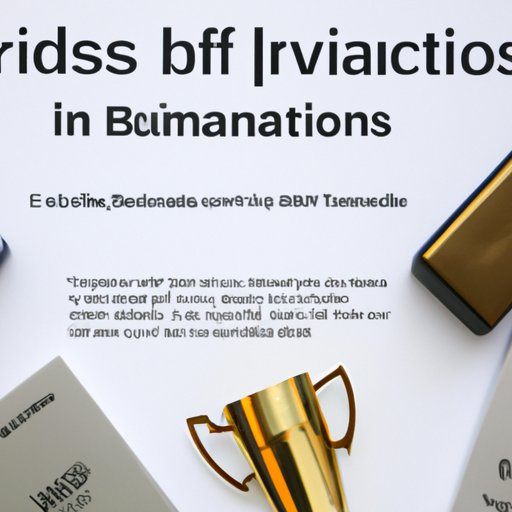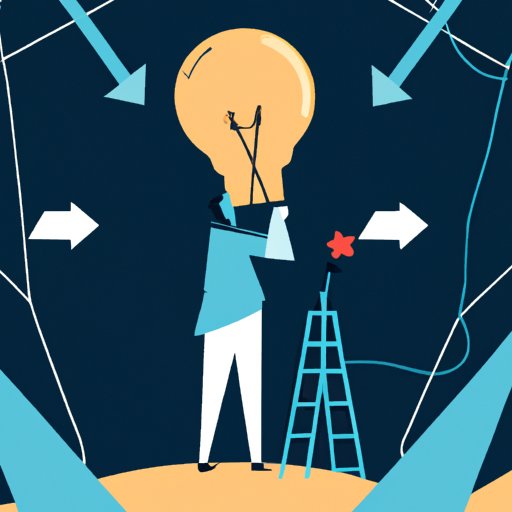Introduction
Innovation is an essential part of any successful business. It’s the driving force behind new products, services, and processes that can help a company stay ahead of the competition. And while there are many strategies that organizations can use to encourage innovation, awards have become increasingly popular as a means of motivating employees and teams to think outside the box. In this article, we’ll explore how awards can inspire innovation, and discuss the role of recognition and competition in creative thinking.

Identifying the Benefits of Awards that Inspire Innovation
Awards can be a great way to recognize and reward innovative thinking. The mere act of receiving an award can provide a strong sense of pride and accomplishment, while also giving recipients the recognition they deserve. But awards can do more than just boost morale—they can also serve as a powerful motivator to spur further creativity. According to research from the Harvard Business Review, “The combination of recognition and competition can be a powerful motivator for innovators and their teams.”
Recognition and competition are two of the key benefits of awards that inspire innovation. Receiving recognition for an innovative idea can be a great motivator for individuals, as it serves as validation that their work is valued and appreciated. Meanwhile, competition can be used to spur creative thinking, as it encourages teams to come up with the best possible solutions to a problem. The challenge of competing against others can be a powerful source of motivation, as it encourages teams to push themselves to come up with unique, out-of-the-box ideas.
Awards can also help to create a culture of innovation within an organization. Not only do awards recognize and reward individual accomplishments, but they can also serve as a symbol of the organization’s commitment to fostering creativity. By recognizing and rewarding innovative thinking, organizations can create an environment that encourages employees to think differently and take risks—which can lead to greater success.

Exploring Case Studies of Innovations Brought About by Awards
There are numerous examples of successful award programs that have spurred innovation. For instance, the X Prize Foundation has been running competitions since 1995 to incentivize the development of groundbreaking technologies. The foundation’s first competition was the Ansari X Prize, which offered a $10 million prize to the first team to develop a reusable spacecraft. That competition eventually led to the development of SpaceShipOne, the world’s first commercial human space flight.
The X Prize Foundation has also recently launched the Global Learning X Prize to encourage the development of open source software that can teach basic reading, writing, and arithmetic skills to children in developing countries. The competition has already resulted in the development of five different software programs that are being used to teach over 400,000 children in Tanzania.
These case studies demonstrate how awards can be used to motivate teams to solve complex problems. They also illustrate the power of recognition and competition when it comes to inspiring innovation.
Examining the Role of Recognition and Competition in Creative Thinking
Recognition and competition can both play a significant role in sparking creative thinking. Receiving recognition for an innovative idea can be highly motivating, as it provides a sense of validation and appreciation for the hard work that went into developing the solution. This recognition can also inspire individuals to continue pushing the boundaries of what’s possible, as they know that their efforts will be rewarded.
Competition can also be a great motivator for creative thinking. By competing against others, teams are encouraged to come up with the most innovative solutions to a problem. This can drive teams to think outside the box and identify potential solutions that they may not have considered otherwise. Additionally, competition can create a sense of urgency, which can be beneficial when it comes to spurring innovation.
Discussing How Awards Can Motivate Individuals and Teams to Think Differently
When it comes to inspiring innovation, it’s important to set clear goals and expectations. Organizations should clearly communicate what types of behavior they want to see from employees, and make sure that those behaviors are rewarded. This will help to ensure that employees understand what is expected of them, and that their efforts will be recognized and rewarded.
Creating an environment that encourages creative thinking is also essential. Organizations should make sure that employees feel safe to take risks and experiment with new ideas. This could include providing resources and support for employees who are working on innovative projects, or creating a culture that emphasizes collaboration and encourages employees to share their ideas.
Analyzing the Impact of Awards on Organizational Culture
Awards can also have a significant impact on organizational culture. By designing awards that reward desired behavior, organizations can create a positive feedback loop that reinforces the behaviors they want to see. For example, if an organization wants to encourage employees to think creatively, they could create an award program that recognizes and rewards innovative ideas. This type of program could have a lasting effect on the organization, as it would demonstrate to employees that their efforts are valued and appreciated.
Organizations should also consider the types of awards they offer. Awards should be designed to incentivize the behaviors that the organization wants to see, and they should also be meaningful enough to encourage employees to strive for them. Awards should also be distributed fairly and consistently, so that all employees have the opportunity to be recognized for their achievements.

Investigating Strategies for Award Programs that Foster Innovation
When designing award programs to foster innovation, organizations should consider the criteria they will use to evaluate innovative ideas. Criteria should be specific and measurable, so that employees know what they need to do in order to receive an award. Organizations should also consider the types of rewards they will offer, such as monetary awards, recognition events, or special privileges. These rewards should be meaningful enough to encourage employees to strive for them.
Organizations should also make sure that award programs are communicated clearly and effectively. Employees should have a clear understanding of the criteria for receiving an award, as well as the rewards and recognition associated with it. This will help to ensure that employees are aware of the award program and motivated to participate.
Conclusion
Awards can be a powerful tool for inspiring innovation. Not only do they provide recognition and competition, but they can also create a culture of innovation within an organization. By setting clear goals and expectations, developing criteria for assessing innovative ideas, and designing award programs that incentivize creative thinking, organizations can use awards to motivate individuals and teams to think outside the box and come up with innovative solutions.
(Note: Is this article not meeting your expectations? Do you have knowledge or insights to share? Unlock new opportunities and expand your reach by joining our authors team. Click Registration to join us and share your expertise with our readers.)
